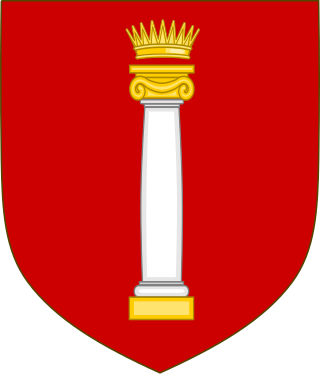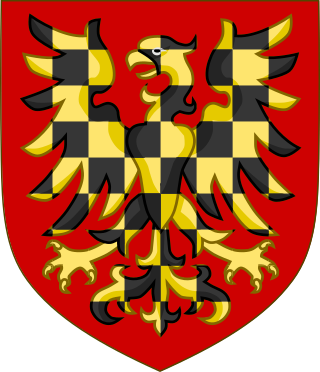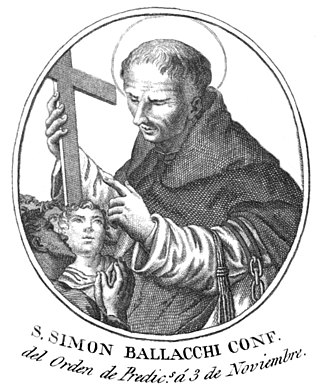Related Research Articles

The House of Colonna, also known as Sciarrillo or Sciarra, is an Italian noble family, forming part of the papal nobility. It was powerful in medieval and Renaissance Rome, supplying one pope and many other church and political leaders. The family is notable for its bitter feud with the Orsini family over influence in Rome, until it was stopped by papal bull in 1511. In 1571, the heads of both families married nieces of Pope Sixtus V. Thereafter, historians recorded that "no peace had been concluded between the princes of Christendom, in which they had not been included by name".

Pope Boniface VIII was the head of the Catholic Church and ruler of the Papal States from 24 December 1294 until his death in 1303. The Caetani family was of baronial origin, with connections to the papacy. He succeeded Pope Celestine V, who had abdicated from the papal throne. Boniface spent his early career abroad in diplomatic roles.

Pope Innocent III, born Lotario dei Conti di Segni, was the head of the Catholic Church and ruler of the Papal States from 8 January 1198 until his death on 16 July 1216.

Pope Innocent XIII, born as Michelangelo dei Conti, was head of the Catholic Church and ruler of the Papal States from 8 May 1721 to his death in March 1724. He is the most recent pope to date to take the pontifical name of "Innocent" upon his election.

The Avignon Papacy was the period from 1309 to 1376 during which seven successive popes resided in Avignon rather than in Rome. The situation arose from the conflict between the papacy and the French crown, culminating in the death of Pope Boniface VIII after his arrest and maltreatment by Philip IV of France. Following the subsequent death of Pope Benedict XI, Philip forced a deadlocked conclave to elect the French Clement V as pope in 1305. Clement refused to move to Rome, and in 1309 he moved his court to the papal enclave at Avignon, where it remained for the next 67 years. This absence from Rome is sometimes referred to as the "Babylonian captivity" of the Papacy.

Anagni is an ancient town and comune in the province of Frosinone, Latium, in the hills east-southeast of Rome. It is an historical and artistic centre of the Latin Valley.

Unam sanctam is a papal bull that was issued by Pope Boniface VIII on 18 November 1302. It laid down dogmatic propositions on the unity of the Catholic Church, the necessity of belonging to it for eternal salvation, the position of the Pope as supreme head of the Church and the duty thence arising of submission to the Pope in order to belong to the Church and thus to attain salvation. The Pope further emphasized the higher position of the spiritual in comparison with the secular order. The historian Brian Tierney calls it "probably the most famous" document on church and state in medieval Europe. The original document is lost, but a version of the text can be found in the registers of Boniface VIII in the Vatican Archives. The bull was the definitive statement of the late medieval theory of hierocracy, which argued for the temporal as well as spiritual supremacy of the pope.
Papal coats of arms are the personal coat of arms of popes of the Catholic Church. These have been a tradition since the Late Middle Ages, and has displayed his own, initially that of his family, and thus not unique to himself alone, but in some cases composed by him with symbols referring to his past or his aspirations. This personal coat of arms coexists with that of the Holy See.
Umiliana de' Cerchi was an Italian Roman Catholic widow and a member of the Third Order of Saint Francis.

The Diocese of Anagni-Alatri is a Latin Church ecclesiastical territory or diocese of the Catholic Church in Lazio, Italy. It has existed in its current form since 1986. In that year the Diocese of Alatri was united to the historical Diocese of Anagni. The diocese is immediately exempt to the Holy See.

Jean Lemoine, Jean Le Moine, Johannes Monachus was a French canon lawyer, Cardinal, bishop of Arras and papal legate. He served Boniface VIII as representative to Philip IV of France, and founded the Collège du Cardinal Lemoine, in Paris. He is the first canon lawyer to formulate the legal principle of the presumption of innocence.

The counts of Segni were an important noble family of medieval and early modern Italy originating in Segni, Lazio. Many members of the family acted as military commanders or ecclesiastical dignitaries, including many cardinals and four popes.
Giovanni Pelingotto was an Italian Roman Catholic member of the Secular Franciscan Order who hailed from Urbino and lived his life as an almsgiver and hermit. Pelingotto served in his father's business before he quit and provided as much alms as he could provide to the less fortunate in his area. This led him into contact with the Franciscans which served to open him to a greater plane of servitude to God and the poor.

Simone Ballachi was an Italian member of the Third Order of Saint Dominic. Ballachi served as a former soldier in Rimini before renouncing that path in favor of the religious life where he became a gardener noted for his strict adherence to the rule of Saint Dominic.
Rinaldo da Concorezzo was an Italian Roman Catholic priest and archbishop who served as the Bishop of Vicenza from 1296 until his 1303 appointment as the Archbishop of Ravenna-Cervia holding that until his death.

Giacomo Bianconi was an Italian Roman Catholic priest and a professed member of the Order of Preachers. Bianconi - who hailed from Umbria - joined the order in his adolescence and dedicated his pastoral career to his flock and on one notable occasion aided refugees when Frederick II sacked the area in 1248. He also combatted heresies and managed to convert one of their chief propagators while also distinguishing himself through his life of extreme poorness that went past the Dominican standards.

Gregorio Celli was an Italian priest of the Roman Catholic Church and a professed member of the Order of Saint Augustine. Celli lived with the latter order in Rimini until he decided to spend the remainder of his life in deep contemplation and so moved to the region's hills where he dwelled in a cave near the Franciscans stationed there. It is claimed he was expelled from his order and became a Franciscan though there is no evidence to support this claim.

Angelo of Foligno - born Angelo Conti - was an Italian Catholic priest and a professed friar of the Order of Saint Augustine. Conti was part of the order of John the Good though became a mainstream Augustinian in 1256 after the Grand Union of the order. He was a close friend of both Saint Nicholas of Tolentino and Blessed Ugolino da Gualdo Cattaneo.
Brynolf Algotsson was a Swedish Catholic prelate and theologian who served as the Bishop of Skara from 1278 until his death. He was descended from nobles and studied for almost two decades in Paris at the college there before returning to his homeland as a dean and canon prior to his episcopal nomination. He was diligent in his work in reforming the education of schools and the overall reorganization of his episcopal see. He was forced into a brief exile but was able to continue his work upon his return.

The Palace of the Popes in Anagni, sometimes called the Boniface VIII Palace, is a building in the ancient hill town of Anagni in central Italy, in the hills east-southeast of Rome. It is closely associated in history with Pope Boniface VIII, was later bought by his nephew Peter II Caetani, and now houses a museum named after the Pope. It is at present part of a property owned by the Cistercian Sisters of Charity and used in part as their motherhouse.
References
- 1 2 3 "Blessed Andrew of Conti". Saints SQPN. 9 June 2016. Retrieved 12 September 2016.
- 1 2 3 4 "Blessed Andrew Segni". Roman Catholic Saints. Retrieved 12 September 2016.
- 1 2 3 4 "Blessed Andrea Conti (De Comitibus)". Santi e Beati. Retrieved 12 September 2016.
- 1 2 3 "Bl. Andrew Segni (of Anagni)". Catholic Online. Retrieved 12 September 2016.
- ↑ Index ac status causarum beatificationis servorum dei et canonizationis beatorum (in Latin). Typis polyglottis vaticanis. January 1953. p. 12.